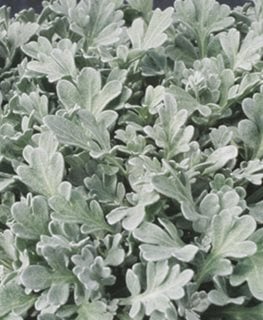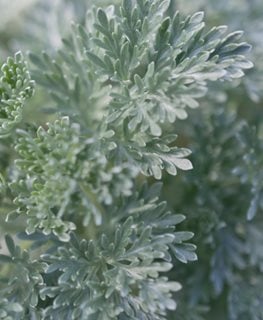HOW TO GROW & CARE FOR ARTEMISIA PLANTS
Add color and texture to the landscape with this carefree plant
Proven Accents® Silver Bullet® Wormwood (Artemisia stelleriana). Photo: Proven Winners
Foliage is an element that is often overlooked in the garden. Artemisia is one of the best plants for creating background interest in the landscape, with silvery leaves and soft texture that is captivating on its own or in combination with other plants.
Most garden varieties of artemisia are herbaceous perennials grown for their ornamental foliage and aromatic qualities. This tough plant needs little care once established, and is tolerant of heat, drought and poor soils.
Here's how to add some of these versatile plants to your landscape.
On this page: Basics | Planting Artemisia | Artemisia Care | Pictures | Design Ideas
On this page:
BASICS
Botanical name:
Artemisia spp.
Common names:
Also known wormwood, absinthe, southernwood, or mugwort.
Hardiness Zones:
3-9, depending on the variety, or grown as an annual
Height/Spread:
Upright, mounding or spreading habit, 6 inches to 6 feet tall and 1 to 12 feet wide, depending on the variety
Exposure:
Full sun
Bloom time:
Summer to fall
Flowers:
The yellow, white or grey flowers are insignificant.
Foliage:
Foliage occurs in shades of silver, grey, white, blue, or green. Leaves are deeply lobed or finely dissected, creating delicate texture in the landscape. The foliage is highly aromatic, with a pungent sage-like or minty scent.
Toxicity:
Mild skin irritation can occur on contact with artemisia foliage. Wash affected area with soap and water. Most varieties of artemisia are safe for pets, with the exception of French tarragon (A. dracunculus), which is toxic to dogs and cats. Wormwood (A. absinthium) is a primary ingredient of absinthe liqueur and vermouth. It contains the chemical thujone, which can be toxic in higher quantities.
Is artemisia invasive?
Some species are invasive in parts of the US. Find out where.
PLANTING ARTEMISIA

'Silver Mound' wormwood. Photo by: Mark Herreid / Shutterstock.
When to plant:
Plant in spring as soon as soil can be worked and after all danger of frost is past.
Where to plant:
Artemisia prefers warm, dry climates. Plant in a sunny site that receives at least 6 hours of direct sun, has good drainage and air circulation. Plants may struggle in regions with humid or wet summers.
How to plant:
Amend planting area with organic matter, taking care not to enrich the soil too much. For clay or other poorly draining soil, add perlite, lava rock, or rice hulls. Soil should be loose and well-draining. If plants are pot-bound, gently tease out the roots.
Dig a hole the size of the root ball and place in the planting hole so the top of the root ball is level with the surrounding soil. Fill in the hole with soil, tamp down gently to remove air pockets, and water thoroughly. Keep evenly moist until plants are established.
ARTEMISIA CARE
Pruning:
Larger shrub types may benefit from a hard prune in early spring. Cut plants back to a few inches above ground, making sure to leave live buds. Cutting back to old wood with no buds may kill the plant. For less severe pruning, trim off errant branches and reshape plants as needed.
In early to mid summer, shear up to half of the growth to prevent flopping or splitting.
Deadheading:
Removing flowers is a personal preference. Cut back blooms as they appear to improve plant appearance and prevent reseeding.
Watering:
Keep soil evenly moist until plants are established. Mature plants will tolerate drought and need little supplemental water. Water once or twice a week in severe heat. Avoid overwatering, which can cause root rot and fungal diseases.
Soil:
Artemisia prefers poor to moderately fertile soil with excellent drainage, and is tolerant of a range of pH levels. Plants are susceptible to root rot in poorly draining or clay soil.
Amendments and fertilizer:
Artemisia prefers lean conditions, needing little to no supplemental fertilizer. If desired, provide a light application of a balanced granular fertilizer in early spring. Overfertilizing can result in floppy plants or a shortened lifespan.
Dividing:
To increase vigor and extend the life of perennial forms, divide plants every 2 to 3 years or when the center of the plant begins to die out. Divide in either spring or fall.
Propagation:
Artemisia is propagated by seed, cuttings or division.
Diseases and pests:
When given the right growing conditions, artemisia experiences few insect or disease problems. Problems such as mildew, rust, and root rot may occur with overwatering, poor air circulation, high humidity, or damp conditions. Pests may include aphids, mites, scale, or leaf beetles. The strong scent of artemisia repels many garden pests.
Deer resistance:
Artemisia is highly resistant to deer, as they dislike the pungent scent and bitter taste.
ARTEMISIA PICTURES
ARTEMISIA ALTERNATIVE:
Senecio cineraria (now known as Jacobaea maritima), is a silver-foliaged tender perennial that is commonly used as an annual bedding plant.
DESIGN IDEAS
There are many ways to incorporate artemisia into your landscape. Here’s how:
- Create a subdued elegant color scheme by combining silver artemisia with pastel-hued plants such as pink gaura, blue catmint, and pale purple lavender.
- For eye-popping contrast, plant silver-foliaged artemisia alongside bold colored perennials such as bee balm, agastache, butterfly weed, red hot poker, and tickseed.
- Combine artemisia alongside plants with contrasting colors, shapes, and texture to create captivating vignettes. For example, the fine foliage and rounded plant shape of artemisia sets off spiky plants with purple or blue flowers such as salvia, veronica, or Russian sage.
- For late-season color, combine artemisia in a dry border alongside ornamental grasses, asters, stonecrop, and coneflower.
- Create a silver and white-themed garden that will shimmer in the moonlight. Use other silver foliaged plants such as lamb’s ear, rose campion, licorice plant, and sea holly, supplementing with white-flowered phlox, lilies, clematis, roses, and hydrangeas. Find more on how to create a moon garden.
- For a dazzling container combination, plant a smaller variety of artemisia alongside petunias, coral bells, African daisies, or small ornamental grasses.
- Liven up a rock garden with low-growing artemisias combined with sea thrift (Armeria), creeping phlox, rock cress (Aubretia), dianthus, and donkeytail spurge (Euphorbia myrsinites). The neutral tones of artemisia help to break up the other colors.
- Plant a low hedge of artemisia to divide garden rooms or edge a pathway.
RELATED:
Native Plants
Drought-Tolerant Plants
Deer-Resistant Plants
20 Best Outdoor Foliage Plants








